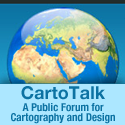Map Update Committee
Nathaniel Vaughn Kelso,
Project Manager
Kelso Cartography
Tom Patterson,
Chief Cartographer
ShadedRelief.com and retired U.S. National Park Service
Dick Furno,
Populated Places Guru
Azimuth, Inc. and The Washington Post (retired)
Tanya Buckingham,
Supervisor of GIS
University of Wisconsin Cartography Lab
Nick Springer,
Website Development
Springer Cartographic
Louis Cross,
NACIS Liaison
Florida Resources and Environmental
Analysis Center @ The Florida State University
The world doesn’t stop changing and, with any project as complex as this, flaws and omissions are bound to emerge, requiring our attention.
The Map Update Committee coordinates this activity and is the final arbitrator on map features, data creation, and data attributes.
Functional: Is linework at the appropriate level of generalization for the scale? Does it represent the feature’s true shape, extent, or position? Does the linework reproduce well in print and online?
Data attributes: Do the names follow our naming policy? Did a typo slip in? Did we get a number wrong or is it now outdated? Does the feature have the right scale rank?
Political features: Natural Earth’s disputed boundary policy is to show de facto administrative boundaries. We show the disputed areas, too, so you can repurpose to suit your needs.
Map Feature Name Guidelines
- The map is intended for an international audience. English is the primary language.
- The GNS database maintained by the U.S. National Geospatial Agency was the main reference for place name spellings of smaller physical features, cities, and seas.
- The density of labels was selected for balanced presentation on a large wall map.
- Labeling physical features took priority over cities and towns, which were included for general orientation and to fill blank places lacking significant physical features.
- Endonyms (Appennino) were favored over exonyms (Apennines) for place names based on Romance and Germanic languages, which are often cognates of familiar English names and easy to identify.
- For other languages, transliterated names of major features (mountain ranges, plateaus, deserts, etc.) received English place name descriptors. For example, Verkhoyansk Khrebet in Russia is labeled on the map as Verkhoyansk Range. Smaller physical features, such as mountains within ranges, have entirely local names.
- Transnational features named in more than one language, for example, the Donau/Duna/Danube River, received conventional English names.
- When two or more countries claim ownership of the same physical feature and use different names for it, the preference was for the country currently in possession of the feature regardless of the circumstances. For example, the southern Kuril Islands that Japan and Russia both claim, and which Russia has occupied since 1945, have Russian names.
- A few notable places have English translations in parentheses, for example, Rub al Khali (Empty Quarter).
- All river names dispense with the word “River” or the abbreviation “R.”
- Island names within compact island groups drop the word “Island” or the abbreviation “I.”
- Non-English place names have accents and diacritical marks. However, the font used on the map (Adobe Frutiger) lacked a few exotic accents for consonants, which consequently do not appear on the map.














